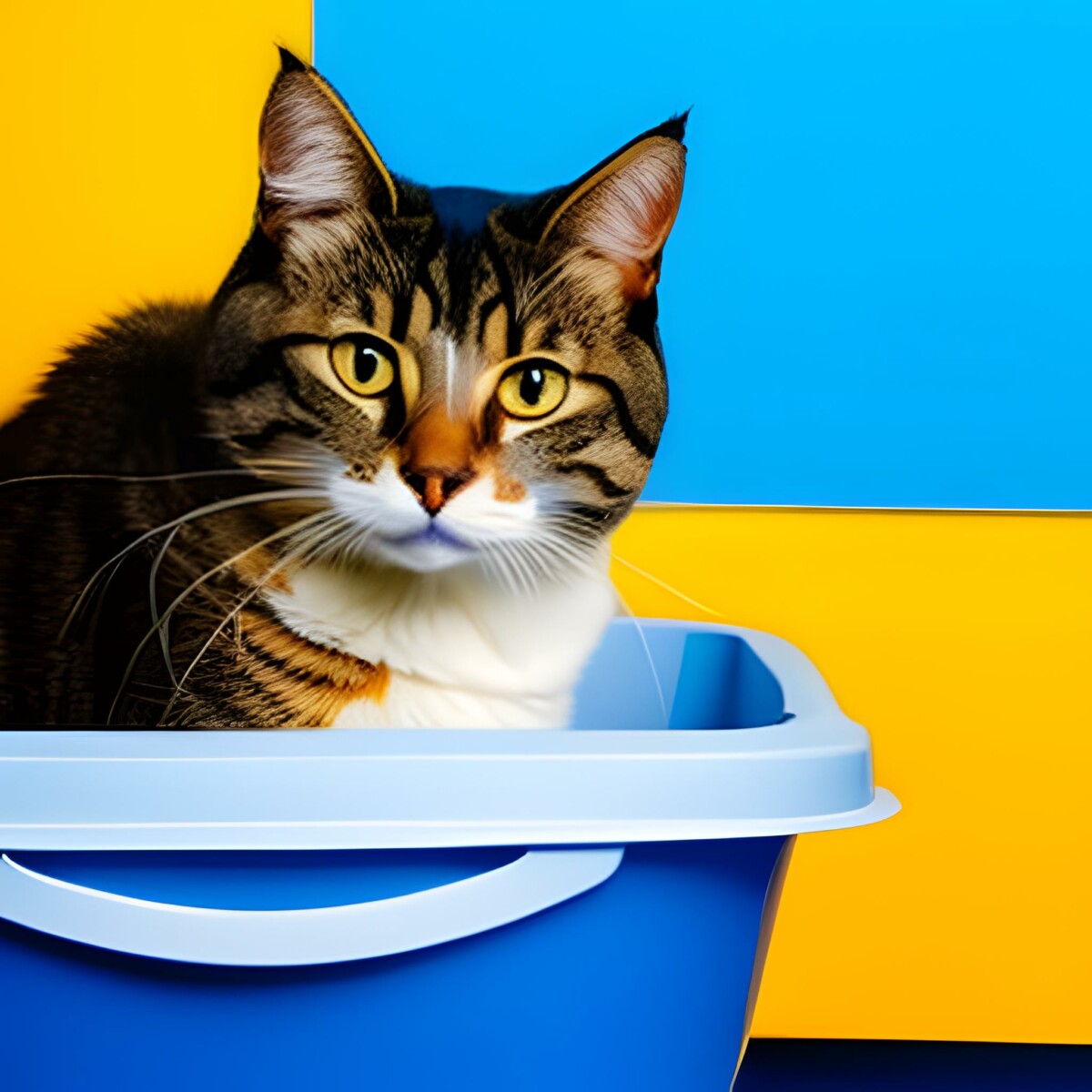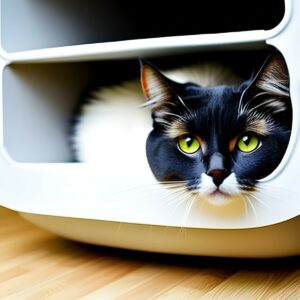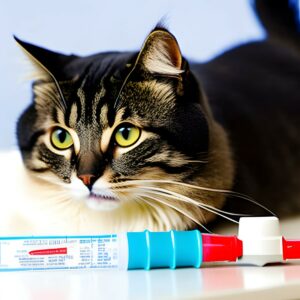Cats are known for their cleanliness regardless of their age. Old cat peeing everywhere (FIE – feline inappropriate elimination) is stressful and challenging for both; the cat and the owner.
Cats can be quite particular about where they choose to urinate and generally prefer a clean and quiet environment and specific litter substrate for their bathroom needs.
They tend to avoid areas with strong smells or where they may have had a negative experience in the past.
In this article, we will explore the possible causes, signs, and house modifications when it comes to a senior feline’s inappropriate urination.
We will also discuss the importance of consulting with a veterinarian to diagnose and treat underlying issues effectively.
Old Cat Peeing Everywhere: Table of Contents
Why is My Old Cat Peeing Everywhere: Understanding the Causes
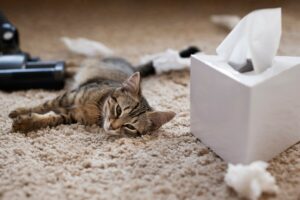
Image by Freepik
The common causes for cat’s urination outside of dedicated places are:
- Age-related health issues,
- behavioral changes,
- environmental factors.
Age-related Health Issues: Medical Conditions
Medical conditions such as:
- degenerative joint disease,
- arthritis,
- kidney disease,
- bladder stones
- UTI,
- diabetes,
- endocrine disorders,
- feline dementia,
These health issues can lead to discomfort and difficulties in accessing the litter box, resulting in urination outside of the designated area.
For example, arthritis can make it difficult for a cat to step into a high-sided litter box or climb stairs to reach it.
In addition to physical difficulties, some illnesses like diabetes, hyperthyroidism, and kidney disease can cause increased thirst and more frequent urination, making it challenging for your cat to reach the litter box in time. If your cat is experiencing any of these health issues, it is essential to consult with your veterinarian to ensure proper treatment and management.
A vet can perform a physical exam, urinalysis, imaging of the bladder or joints, and blood testing to diagnose the underlying issue. Treatment will depend on the diagnosis.
Behavioral Changes in Senior Cats
Cognitive dysfunction, also known as feline dementia, can affect your cat’s memory, making them forget the litter box location or lose their way.
This mental decline can lead to confusion, disorientation, and increased stress, resulting in an old cat peeing everywhere but the litter box.
Reduced interaction, aggression, or anxiety stemming from changes in the household, such as a new pet or family member, can trigger inappropriate elimination as well.
A stable and predictable environment for your senior cat can minimize stress and anxiety.
Environmental Factors Affecting Old Cats
Stressful environments, changes in litter type or the placement of the litter box, and excess noise levels can all contribute to your older cat’s peeing problems.
In addition, cats may avoid poorly maintained or dirty litter boxes, which can lead them to urinate in other areas of your home.
It is crucial to provide a comfortable and familiar atmosphere for your senior cat to prevent roaming and peeing in undesirable locations.
Consider providing multiple litter boxes in different locations to accommodate your cat’s needs and preferences. Keep the litter boxes clean and accessible, and avoid sudden changes in the litter type or location to minimize stress and anxiety.
Identifying the Signs of Inappropriate Urination: Incontinence
Noticing the symptoms of inappropriate urination and taking prompt action can help you manage your cat’s peeing with ease.
Monitoring unusual urination patterns, detecting unpleasant odors, and spotting wet or stained surfaces are some vital aspects to consider.
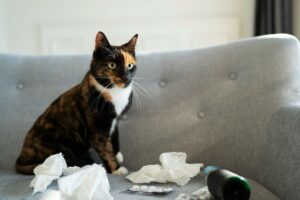
Unusual Urination Patterns
One of the first signs of inappropriate urination is erratic patterns. Take note if your cat is urinating in smaller amounts more frequently than usual or expressing difficulty while doing so.
They might also visit the litter box more often, even without using it. These behaviors will help you determine whether the issue is health-related or environmental.
Strong or Unpleasant Odors
Cat urine has a distinct and strong odor. Be alert if you perceive a lingering smell in the house, even after cleaning the litter box. Detecting the unusual odor can help you to track the areas where your cat is inappropriately urinating, enabling you to take proper measures to clean and prevent further mishaps.
Wet or Stained Surfaces
Regularly check your home’s floors, carpets, and furniture for wet spots or stains. If you notice urine stains, promptly clean them with an enzyme cleaner specifically designed for tackling cat urine to get rid of the smell, thus deterring future accidents.
Consulting with a Veterinarian
After identifying the problem, consulting with a veterinarian is a crucial step to rule out any health-related issues and discuss your concerns. Your vet will take a detailed history and carry out necessary examinations to arrive at the correct diagnosis and create a personalized treatment plan for your cat.
Diagnosing Health Problems
Your veterinarian may perform a physical examination as well as blood and urine tests to diagnose any underlying health condition causing inappropriate urination. Identifying and treating these issues is essential to resolving your old cat’s peeing problem and ensuring their well-being.
Discussing Behavioral Concerns
During your vet visit, discuss any behavioral concerns or signs indicating stress, anxiety, or cognitive decline that might contribute to the issue. Your veterinarian may recommend medications, supplements, or behavioral therapy to address these problems and improve your cat’s peeing habits.
Creating a Treatment Plan
Once your vet has identified the problem, they will create a comprehensive treatment plan tailored to your cat’s needs. This plan may include medications, changes in diet, and recommendations for litter box modifications, among other strategies.
Implementing Changes at Home
In addition to your veterinarian’s recommendations, certain modifications at home can prove helpful in managing your old cat’s inappropriate urination. Modifying the litter box setup, addressing environmental stressors, and encouraging proper hydration are essential steps to consider.
Modifying the Litter Box Setup
Ensure your cat has easy access to a clean litter box. Use a low-sided box to accommodate mobility issues and place it in a quiet, accessible location. If you have multiple cats, provide at least one litter box per cat, plus an additional one to reduce competition and ensure availability.
Addressing Environmental Stressors
Identifying and reducing sources of stress in your home can aid in resolving your old cat’s peeing issues. Introduce new pets or family members gradually, offer hiding spaces or perches to encourage your cat’s sense of control, and use pheromone diffusers to create a calming environment.
Encouraging Proper Hydration
Inadequate water intake can lead to concentrated urine, which can irritate the urinary tract and exacerbate inappropriate urination.
Encourage your old cat to drink more water by providing fresh, clean water in multiple locations or using water fountains.
A wet-food diet can also increase their water consumption, promoting urinary tract health.
Tips and Takeaways
Here are some tips for addressing an old cat peeing everywhere:
- Consult with a veterinarian to rule out any underlying medical conditions that may be causing the behavior.
- Provide a convenient and easily accessible litter box for your senior cat. Consider using a litter box with lower sides that your cat can easily step into.
- Ensure that the litter box is large enough and cleaned regularly to keep it appealing to your cat. Avoid using strongly scented cleaners that may be unpleasant for your cat.
- Consider using a litter box with a ramp to make it easier for your cat to access.
- Provide multiple litter boxes in different locations to make it more convenient for your cat to use.
- Try using a different type of litter to see if your cat prefers a specific texture or scent.
- Ensure that your cat has easy access to food and water, as dehydration may lead to urinary issues.
- Use enzymatic cleaners specifically designed for pet urine to remove any odor and prevent your cat from returning to the same spot.
- Provide your cat with playtimes and mental stimulation to keep them active and engaged. Boredom and lack of stimulation may lead to inappropriate urination.
Remember, every cat is unique, and what works for one may not work for another.
We developed a comprehensive guide on senior cat care that might be useful as well.
If you continue to have issues with your senior cat’s urination behavior, it’s always best to consult with your veterinarian for personalized advice and treatment.
My Senior Paws is a participant in the Amazon Services LLC Associates Program, an affiliate advertising program designed to provide a means for sites to earn advertising fees by advertising and linking to Amazon.com. We also participate in other affiliate programs which compensate us for referring traffic.
